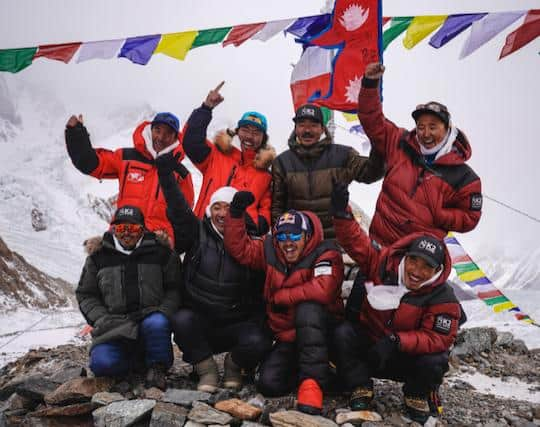What is a Gurkha and a Sherpa? Terms explained as Nepali climbers break record by reaching K2 summit
Nepalese mountain, K2, is the second highest peak in the world after Mount Everest, standing at 28,251-feet (8,611 meters) tall.
Prior to Saturday 16 January, no one had reached the summit in winter, as it is considered the most difficult in the world to climb - with treacherous conditions and a technically challenging mountain face.
Advertisement
Hide AdAdvertisement
Hide AdHowever, a squad of 10 sherpas have now ascended to the peak in a historic climb which makes K2 the last of the world's tallest 14 mountains to be scaled in winter.


But who was on the team of sherpas - and what does the term mean?
Who was in the team?
The ascent was originally being attempted by three separate Nepali groups - one led by Nirmal ‘Nims’ Purja, the other by Mingma G Sherpa.
They had been joined at the foot of the mountain by a further 50 mountaineering hopefuls - 22 paying clients and 27 sherpa support staff - in a bid to make history on K2, otherwise known as “the savage mountain”.
However, as the ten climbers reached the basecamp of the summit, already 5,000 meters up, they formed one group in a bid to succeed.
This is not the first time the groups have assisted in summiting the peak of the world’s 14 mountains higher than 8,000 feet.
In 2019, former Gurkha, Nirmal Purja, succeeded in climbing all 148,000-meter peaks in a record six months, six days - beating previous attempts by more than seven years, but this was not during winter.
On these climbs, he was joined by various members of the Sherpa community who aided with climbing kit and some of whom were with him at the winter summit of K2.
Advertisement
Hide AdAdvertisement
Hide AdJoining Purja at the top was Mingma Gyalje Sherpa, Gelje Sherpa, Mingma David Sherpa, Mingma Tenzi Sherpa, Dawa Temba Sherpa, Pem Chhiri Sherpa, Kilu Pemba Sherpa, Dawa Tenjing Sherpa, and Sona Sherpa, who had originally been a member of a different Sherpa team.
What does Sherpa mean?
Sherpa is the name of the ethnic group of people who live in the mountains of Nepal, central Asia.
It can also be used to describe the name of mountain guides working in the Mount Everest mountain range.
Was everyone on the team a Nepalese national?
The climb has been classed as a moment of national pride for the Nepalese community, as all 10 team members were Nepalese nationals.
Purja was also a former British Special Forces Soldier who spent time in Eastleigh, England. Known as a Gurkha - he had been recruited by the British Army from his native Nepal.
Gurkha is the term used for native South Asia of Nepalese national soldiers recruited for the British Army.
Purja is thought to have led his team, as well as the others, in their historic expedition - the 10 men sang the Nepalese national anthem as they ascended the last few hundred yards to the icy peak.
Purja said of the climb: “We set out to make the impossible possible.”
Advertisement
Hide AdAdvertisement
Hide Ad“Mother nature always has bigger things to say and standing on the summit, witness to the sheer force of her extremities, we are proud to have been a part of history for humankind and to show that collaboration, teamwork and a positive mental attitude can push limits to what we feel might be possible,” he added.
The news of their success came at 5pm local time in Pakistan, which was reportedly celebrated across Nepal.
Now, their country awaits news of their successful descent, thought to be the hardest part of the climb.
How did they climb K2 in the wintery conditions?
The team faced several setbacks in their fight to reach the top, sleeping in the mountain’s shallow crevices at one stage due to high winds making it impossible to pitch a tent.
Further to this, Purja shared on his social media during their climb: “Our team reached Camp 2 today and it was a wreckage site. We have lost everything.”
“I am devastated to be breaking this news. Now, I have to reassess and replan everything.”
However, the team managed to source essential climbing materials when they reached basecamp - 5,000 meters up - and ascended the further 6311 meters successfully.
Temperature reached a treacherous -58C and a lack of oxygen proved too much for many other mountaineering hopefuls to endure.
Advertisement
Hide AdAdvertisement
Hide AdHowever, the team’s decision to work together - sharing equipment and creating several miles of fixed ropes into the mountain face - seems to have been the winning strategy and has proved essential in the ascent and arguably, the more dangerous descent.
Statistics show that for every three climbers who reach the summit of K2 - only ever achieved in hotter conditions - one dies somewhere on the mountain.
The team of ten will face overcoming this statistic, while battling against exhaustion and potential snow falls.
One of the many climbers who turned back on the mountain during the weekend, Spaniard Sergi Mingote, died after experiencing a severe fall.